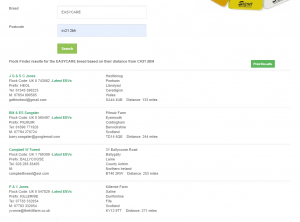Sheep breeders spend a huge amount of time and energy collecting data through mating, lambing and during the growing season to evaluate the performance of their flock. Details of the lambs’ parents and grandparents, their litter mates and weights at birth, eight and at scanning (around 15-21 weeks when animals are 40-50 kg). For some breeders, muscle and fat measurements on the loin through ultrasound scanning are collected according to a well-known protocol.
Some breeders supply their data to services like Signet’s Sheepbreeder to produce estimated breeding values (EBVs). They calculate how much of each animal’s performance is due to its breeding merit, and how much is due to the environment in which it has been raised. EBVs have been used in the UK sheep industry for over 30 years and offer a practical and unbiased guide to whether a ram will do the job expected.
Breeders can submit their data to Signet in a variety of ways, ranging from EID software systems to paper records. We are encouraging breeders to enter their own data online or submit it electronically to reduce the costs to them. It is then checked as it enters the Signet database with mistakes queried with the breeders. EGENES, part of SRUC based in Edinburgh, access the database at agreed times and calculate EBVs for new animals and update the breeding values for existing animals using new information from relatives. EGENES will also generate the accuracy figures based on the amount of data behind each EBV.
The latest breeding values at the click of a button
EBVs are loaded onto the Signet database for breeders and commercial ram buyers to access. Each time an analysis is completed, every animals’ breeding merit will be updated. Breed benchmarks for the EBVs will be generated from the previous year’s data, which allows breeders and buyers to see where the ram sits within the breed.
The figures can be regularly accessed by the breeders who will use them to make decisions about which animals to keep, to sell and then to work out mating plans. The availability of the figures online means they can identify animals in other flocks that can help their breeding programmes.
Anyone can access the website and look for rams or flocks (through flock finder). Searches can be done on ram’s location and specific breeding criteria, e.g. Lleyn with a top 25% index and top 30% maternal ability. A new function of the website is a list of sheep for sale.
Image from the flock finder for Easy Care sheep

